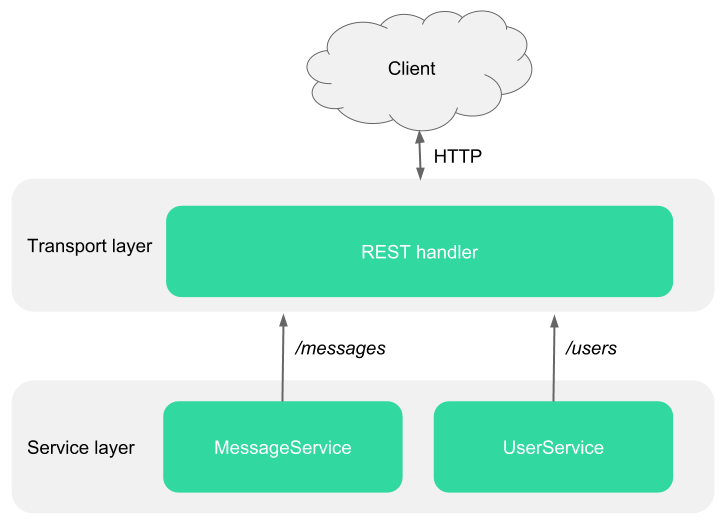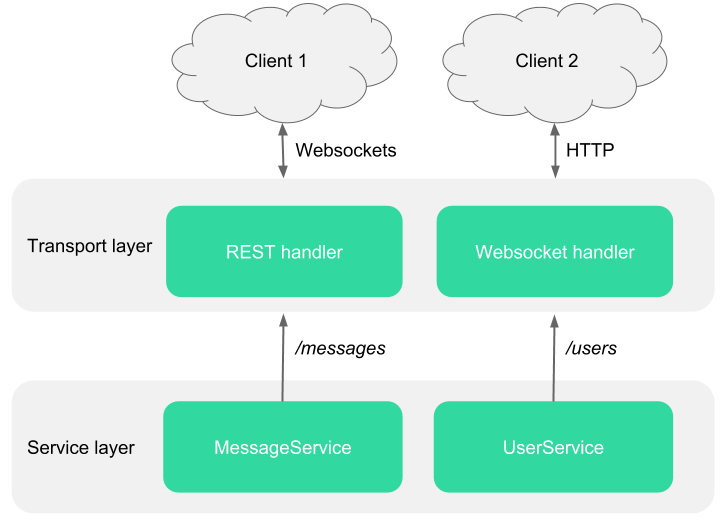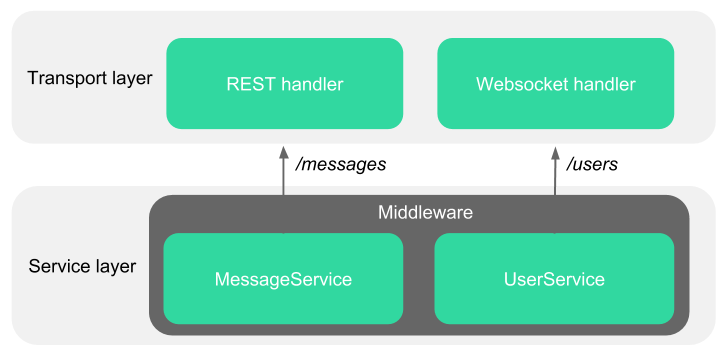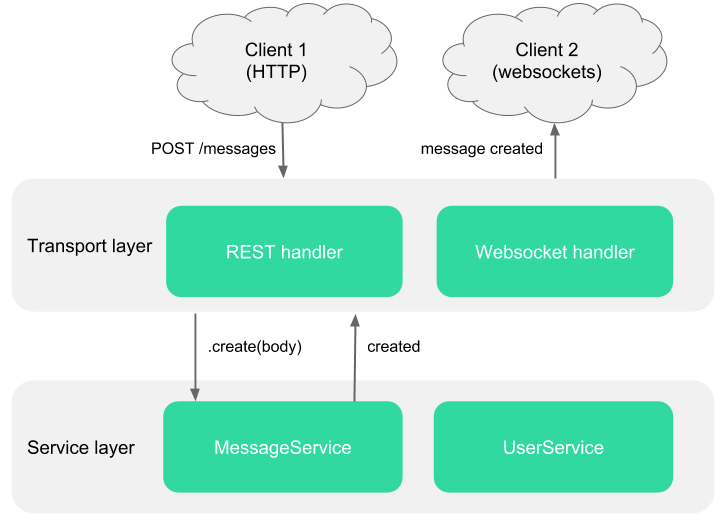For the past decade, much of my professional life has evolved around
making applications and (web)servers talk to each other. After making
several contributions to one of the first client side JavaScript frameworks
in 2007, I became inspired by the idea of small, data-driven web APIs.
Three years later, I had the opportunity to research and implement a
project that allowed to make an application available through different
remote procedure call (RPC) protocols as my university final thesis.
Since then I had the chance to use and refine many of the patterns I researched during that time in many different environments, from private projects over startups to some of the biggest technology companies in the world and in many different programming languages from Java and Groovy over Python and PHP to NodeJS, where Feathers is the latest distillation of this journey.
3.Transport Agnostic :
It gives us an intuitive but powerful abstraction for dealing with almost any kind of data:
class MessageService {
// Find a list of resources
find(params) {},
// Get a single resource by its id
get(id, params) {},
// Create a new resource
create(data, params) {},
// Replace an existing resource by its id with data
update(id, data, params) {},
// Merge new data into a resource
patch(id, data, params) {},
// Remove a resource by its id
remove(id, params) {}
}
This interface allows us to implement our application logic in a resource oriented way with all the advantages discussed in the service layer and REST sections. Although it directly reflects the HTTP methods, it is protocol independent and we do not have to write individual HTTP request and response handlers. Instead, this can be done in a separate handler that only has to know about this service interface.


This Wikipedia definition might sound a little abstract but it is very common especially in NodeJS where it is known as middleware and popularized by web frameworks like Express and Koa. The idea is to have layers of HTTP request/response handlers that each do something specific and can decide when to pass processing on to the next handler. The following example shows a Koa application with middleware that
});
app.use(async (ctx, next) => {
// Set response body (will be sent as JSON)
await next();
});
app.use(async (ctx, next) => {
// Add the url to the response body
ctx.body.url = ctx.request.url;
await next();
});
app.listen(3000);
Although most popular for handling HTTP requests this pattern is generally very helpful for anything that requires a configurable asynchronous processing workflow. Applied to our RESTful service layer we can register the same kind of middleware for each method.

//Replace an existing source by its id with data
update (id,data,params) {},
//Merge new data into a resource
patch(id,data,params) {},
//Remove a resource by its id
remove(id,params) {}
}
const messages = new MessageService();
// Log the runtime for all method calls
messages.use(async (ctx, next) => {
// Store the start time
const start = Date.now();
// Pass to the next middleware and wait for everything to return
await next();
// Calculate the total runtime everything took
// Log runtime with method name
console.log(`Calling ${ctx.method} took ${ms}ms`);
});
messages.use({
// For `create`, add the current date as `createdAt` before saving everything to the database
create: [async (ctx, next) => {
ctx.data.createdAt = new Date();
// Go on to the next step (actual service `create` in this case)
await next();
});
Here we can already see how the runtime and

I believe that especially the protocol independent and real-time approach will be very important for the future of connected applications and would love to see more frameworks and applications exploring it.
Since then I had the chance to use and refine many of the patterns I researched during that time in many different environments, from private projects over startups to some of the biggest technology companies in the world and in many different programming languages from Java and Groovy over Python and PHP to NodeJS, where Feathers is the latest distillation of this journey.
More important than the choice of programming language or framework however are the design patterns that we can use to help us create software:
Design patterns are formalized best pratices that the programmer can solve common problems when designing an Application or System :
Service Layer
The service layer is a common interface to your application logic that
different clients like a web interface, a command line tool or a
scheduled job can use. According to Patterns Of Enterprise application architecture the service layer .
Defines an application’s boundary with a layer of
services that establishes a set of available operations and coordinates
the application’s response in each operation .
In its basic form, a service layer provides a set of methods that any other client can use:
class ChatApplication {
login (username, password) {},
logout (user) {},
joinChatRoom(roomId, user) {}
sendMessage(message, roomId, user) {}
sendPrivateMessage(message, receiverId, user) {}
}
The service layer methods itself then implement the application logic
and make calls to the databases or models. It does not have to be a
class but can also be a set of functions that are publicly exposed. In
the context of web APIs, both ways offer several advantages:
1.Separation of Concerns and Testability:
Instead of implementing all functionality directly e.g. in the
controller actions or route handlers of a web framework, the service
layer allows to test the application logic separate from how it is being
accessed. A CLI, GUI or web framework that uses the service layer then
only needs integration tests instead of having to test the integration
and application logic at the same time.
2.Self Documenting :
New developers can see what the application provides in the context of
the programming language (classes or functions that can be called)
instead of having to read often outdated documentation or
reverse-engineer external HTTP API interfaces.
3.Transport Agnostic :
Different clients, like a message queue integration or a scheduled job
can use the application directly or through a more appropriate transport
protocol without being forced to use HTTP.
REST
Representational State Transfer (REST) is an architectural style that
defines a set of constraints for creating web APIs. The term was coined
by Roy Fielding in his PHD thesis
and expands many of the design decisions that went into the HTTP
protocol into a more high level architecture. Although it is most often
used in the context of HTTP, REST is an architectural design pattern and
not a communication protocol. As one implementation of the REST
architecture, HTTP is considered a RESTful protocol.
Constraints
Since it is not a formally defined protocol there are many opinions on
the details of implementing REST APIs. However, the following five
constraints must be present for any application to be considered
RESTful:
1.Client-server
A client-server architecture allows a clear separation of concerns. The
client is responsible for requesting and displaying the data while the
server is taking care of data storage and application logic. One
advantage is that both sides can be developed separately as long as the
agreed-upon request format is followed.
2.Statelessness
Communication between client and server is stateless. This means that
every client request contains all the information necessary for the
server to process the request. This further reduces server complexity
since no global state (other than a possibly shared database) is
necessary and improves scalability since any request can be processed by
any server.
3.Caching
Stateless client-server communication can increase server load since
some information may have to be transferred several times so requests
that only retrieve data should be cache-able.
4.Layered system
A key feature of most networked systems. In the context of REST, this
means that a client can not necessarily tell if it is directly
communicating with the server or an intermediate (proxy).
5.Uniform interface
REST defines a set of well defined operations that can be executed on a resource. These will be discussed below.
Resources and operations
One of the key concept of REST (and the HTTP protocol) are resources. A resource can be anything that is uniquely addressable.
This blog post, a list of all my blog posts, a file on a server, an
entry in a database or the weather data for a location. The HTTP
protocol define a set of operations that can be executed on a single or
multiple resources:
GET: A safe read-only method that reads a single or a list of resources.
POST: Creates a new resource.
PUT: Completely replaces the resource(s) at the given location with the new data.
PATCH: Merges the resource(s) at the given location with the new data.
DELETE: Deletes the resource(s) at a location.
HEAD: Same as GET but only returns the header and no data.
The concept of resources and operations is well defined in the HTTP specification.
Interestingly this is something very few web frameworks actively try to
help with. Instead of helping to deal with resources and those
operations they either focus on low-level handling of individual HTTP
requests and responses (routing, headers etc.) or forcing the resource
oriented HTTP protocol and its operations into arbitrary (controller)
actions. I still believe that the inconsistencies in many web APIs that
claim to be RESTful are not a problem of REST as an architecture but of
web frameworks failing to provide the structure to follow it properly.
Ultimately it is mostly a conceptual change in how to approach an application interface. Instead of implementing actions (
createUser, resetPassword or sendMessage) we can look at it from the perspective of resources and operations (user.create , user.patch({ password }) or message.create). If we limit the operations to those already defined in the HTTP protocol this maps naturally to a web API.A RESTful service layer
In the service layer section we looked at the advantages that it can
bring to testability, protocol independence and self-documentation. This
can now be combined with the REST constraints of resources and a
uniform interface to create a protocol independent service that mirrors
the HTTP methods:
|
HTTP
method
|
Service
layer method
|
||
|
GET
/messages
|
messages.find()
|
||
|
GET
/messages/1
|
messages.get(1)
|
||
|
POST
/messages
|
messages.create(body)
|
||
|
PUT
/messages/1
|
messages.update(1,
body)
|
||
|
PATCH
/messages/1
|
messages.patch(1,
body)
|
||
|
messages.remove(1,
body)
|
class MessageService {
// Find a list of resources
find(params) {},
// Get a single resource by its id
get(id, params) {},
// Create a new resource
create(data, params) {},
// Replace an existing resource by its id with data
update(id, data, params) {},
// Merge new data into a resource
patch(id, data, params) {},
// Remove a resource by its id
remove(id, params) {}
}
This interface allows us to implement our application logic in a resource oriented way with all the advantages discussed in the service layer and REST sections. Although it directly reflects the HTTP methods, it is protocol independent and we do not have to write individual HTTP request and response handlers. Instead, this can be done in a separate handler that only has to know about this service interface.

Another advantage of this approach is that we can add handlers for other protocols without having to change our services. Websockets,
for example, can not just send events from the server to the client.
Most websocket libraries allow fully bi-directional communication that can completely replace HTTP and often also be faster.

Middleware
While the RESTful service layer gives us a neat interface to create
RESTful web APIs, most applications also require functionality that is
not part of a services core responsibility or that applies to multiple
services (cross-cutting concerns). For example:
- Checking permissions
- Data validation and conversion
- Sending an email when a new user is created
- Updating the stock information when an order was submitted
The solution has many different names: Middleware, Unix pipes, Aspect
Oriented Programming, Feathers hooks, but it all comes down to the same
thing. What we need is a way to register functionality that runs before
or after a method. It should have access to the context of the method
call and can decide when and if it wants to pass control to the next
step. It may also run further functionality once all other middleware
has completed (e.g. for logging or adding information to the result).
In Aspect Oriented Programming,
which allows to add additional functionality into classes, this is done
at compile time. For dynamic languages it can be a little more flexible
by extending the methods at run time. One pattern used for this in
languages that allow a more functional approach is the so called continuation-passing style:
In functional programming, continuation-passing style (CPS) is a style of programming in which control is passed explicitly in the form of a continuation.
This Wikipedia definition might sound a little abstract but it is very common especially in NodeJS where it is known as middleware and popularized by web frameworks like Express and Koa. The idea is to have layers of HTTP request/response handlers that each do something specific and can decide when to pass processing on to the next handler. The following example shows a Koa application with middleware that
- Stores the request start time, then continues to the next handler. Once all following handlers complete it will calculate the total time and log it.
- Sets the body to a
{ message: 'Hello world' }object which will be serialized as JSON. - Adds the current request
urlto the body object.
const Koa = require('koa');
const app = new Koa();
app.use(async (ctx, next) => {
// Store the start time
| const start = Date.now(); |
| // Pass to the next middleware and wait for everything to return | |||||
| await next(); |
|---|
| // Calculate the total runtime everything took |
|---|
| const ms = Date.now() - start |
|---|
| ctx.set('X-Response-Time', `${ms}ms`); |
|---|
| console.log(`Request to ${ctx.request.url} took ${ms}ms`); |
|---|
| ctx.body = { message: 'Hello world' }; |
Although most popular for handling HTTP requests this pattern is generally very helpful for anything that requires a configurable asynchronous processing workflow. Applied to our RESTful service layer we can register the same kind of middleware for each method.

Instead of the HTTP request or response in the context it contains protocol independent information about the parameters (e.g.
class MessageService {
// Find a list of resources
find(params) {},
id, data or params) and how it was called (e.g. the method name and service object):class MessageService {
// Find a list of resources
find(params) {},
// Get a single resource by its id
get(id,params) {},
//Create a new resource
create(data,params) {},
get(id,params) {},
//Create a new resource
create(data,params) {},
update (id,data,params) {},
//Merge new data into a resource
patch(id,data,params) {},
//Remove a resource by its id
remove(id,params) {}
}
const messages = new MessageService();
// Log the runtime for all method calls
messages.use(async (ctx, next) => {
// Store the start time
const start = Date.now();
// Pass to the next middleware and wait for everything to return
await next();
// Calculate the total runtime everything took
| const ms = Date.now() - start; | ||
console.log(`Calling ${ctx.method} took ${ms}ms`);
});
messages.use({
// For `create`, add the current date as `createdAt` before saving everything to the database
create: [async (ctx, next) => {
ctx.data.createdAt = new Date();
// Go on to the next step (actual service `create` in this case)
await next();
| }] | |
Here we can already see how the runtime and
createdAtReal-Time
Real-time updates mean that clients get actively notified about changes
in the system. It is not a part of the REST architecture or the HTTP
protocol but it fits almost naturally into the concept of the uniform
interface. Since we know the side effects of each method we can
automatically send certain notifications once they complete:
| HTTP method | Service layer method | Real-time event |
|---|---|---|
| GET /messages | messages.find() | - |
| GET /messages/1 | messages.get(1) | - |
| POST /messages | messages.create(body) | message created |
| PUT /messages/1 | messages.update(1, body) | message updated |
| PATCH /messages/1 | messages.patch(1, body) | message patched |
| DELETE /users/1 | messages.remove(1, body) | message removed |
Clients can then listen to the events they are interested in and update
their state accordingly. This also fits well into the RESTful service
layer and middleware pattern. Sending those events can be implemented as
just another middleware that runs last and publishes the final result.
Even though HTTP does not support real-time updates, clients using other
protocols (like websockets) can also still be notified about those
events through their protocol handler.

This is a great middle ground between completely custom websocket events
and proprietary real-time solutions like Firebase key-value
observation. With completely custom events it is all up to the developer
to know what the event means and make the appropriate updates whereas
out-of-the-box solutions like Firebase or Meteor use real-time protocols
that are difficult to use directly and usually require specific client
side libraries.
With events from RESTful services we know which events we will get and
what data to expect. This allows to create generic tooling without
having to implement a complex real-time data protocol. These events
combine especially well with functional reactive programming (FRP) to create user interfaces based on real-time data streams.
Wrapping up
Design patterns are best practises that can help us create software that
is more maintainable, flexible and easier to understand no matter which
programming language or framework. In this post we looked at several
design and architectural patterns that can help create web APIs:
- Service layer: A protocol independent interface to our application logic
- REST: An architectural design principle for creating web APIs
- RESTful services: A service layer that follows the REST architecture and HTTP protocol methods
- Middleware: Reusable functions that can control the flow of data and trigger additional functionality when interacting with REST services
- Real-time: A set of events that can be sent automatically when following the REST architecture
I believe that especially the protocol independent and real-time approach will be very important for the future of connected applications and would love to see more frameworks and applications exploring it.






I must say, this is really an awesome post which you have shared in a simple and easy to grasp way. Thanks for sharing this post.Full Stack Development Company Texas
ReplyDeleteThanks for your great blog. But you can also find something new for ionic framework app development that is easily available and can learn very partly. It is cost-efficient and reduces the need for maintenance too.
ReplyDeleteYou might have heard about Flutter app development, one of the quickest ways to build native-like apps. I have created a list of leading Flutter app development company after conducting deep research. This will not only help you in saving time but also lets you find your perfect partner considering your requirements.
ReplyDeletei am for the first time here. I found this board and I in finding It truly helpful & it helped me out a lot. I hope to present something back and help others such as you helped me. Nisar Technology
ReplyDeletevery interesting post.this is my first time visit here.i found so many interesting stuff in your blog especially its discussion..thanks for the post! forex copy trading
ReplyDeleteHelpful content for us. Have you need of cheap flights to florida, cheap flights to new york, cheap flights, cheap tickets,
ReplyDeleteflights to vegas, flights to miami Cheaper airfare to long distance travel by flights. Book a flights to anywhere with the help of online price comparison
this is really an awesome post which you have shared in a simple and easy
ReplyDeleteFull Stack Training in Chennai | Certification | Online Training Course| Full Stack Training in Bangalore | Certification | Online Training Course | Full Stack Training in Hyderabad | Certification | Online Training Course | Full Stack Developer Training in Chennai | Mean Stack Developer Training in Chennai | Full Stack Training | Certification | Full Stack Online Training Course
Amazing post. Widle Studio is one of the best Flutter App Developer in Florida, United States. It develops Apps for all types of screen.
ReplyDeleteExcellent website! I adore how it is easy on my eyes it is. I am questioning how I might be notified whenever a new post has been made. Looking for more new updates. Have a great day! dotcomsecrets
ReplyDeleteArka Softwares offer end-to-end React Native app development services that includes requirement gathering to deployment. Our React native development services have reached myriad startups and large enterprise customers of various industries.
ReplyDelete